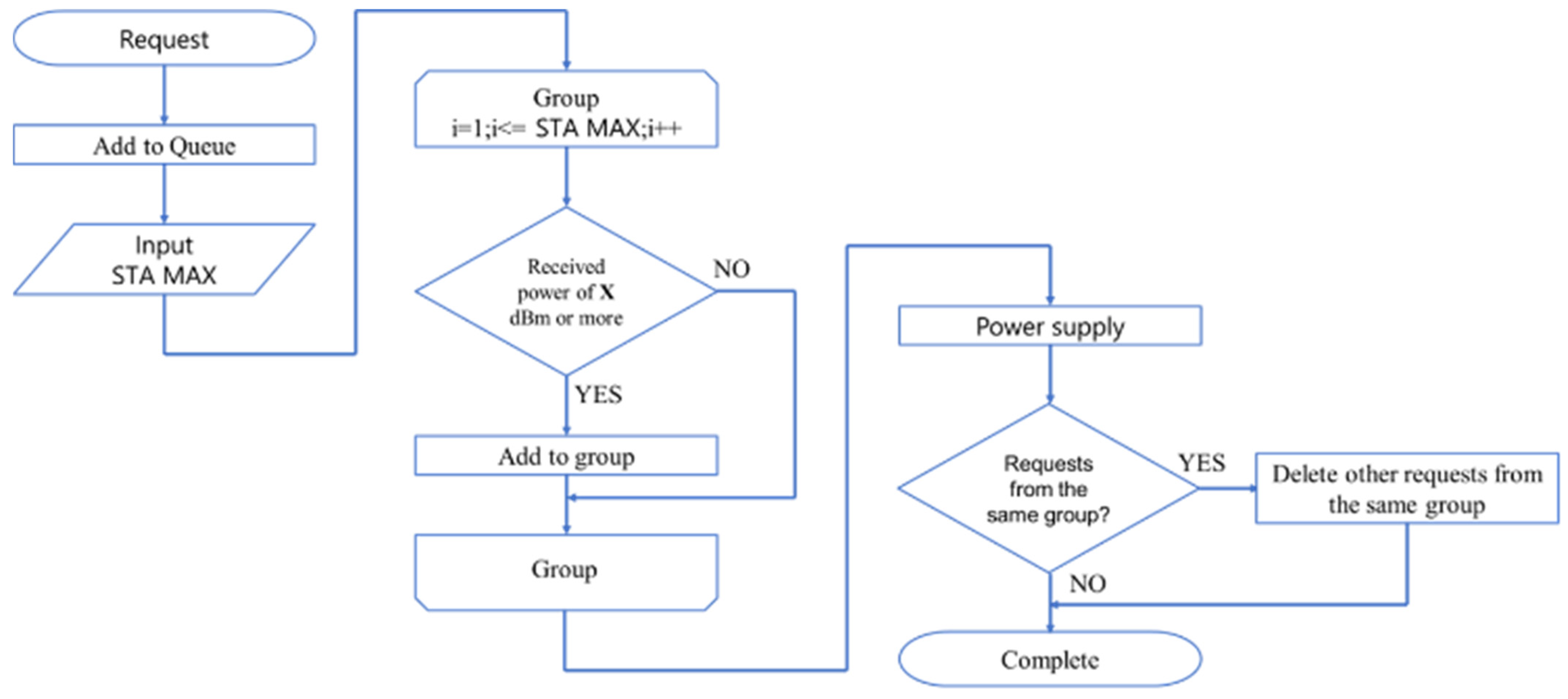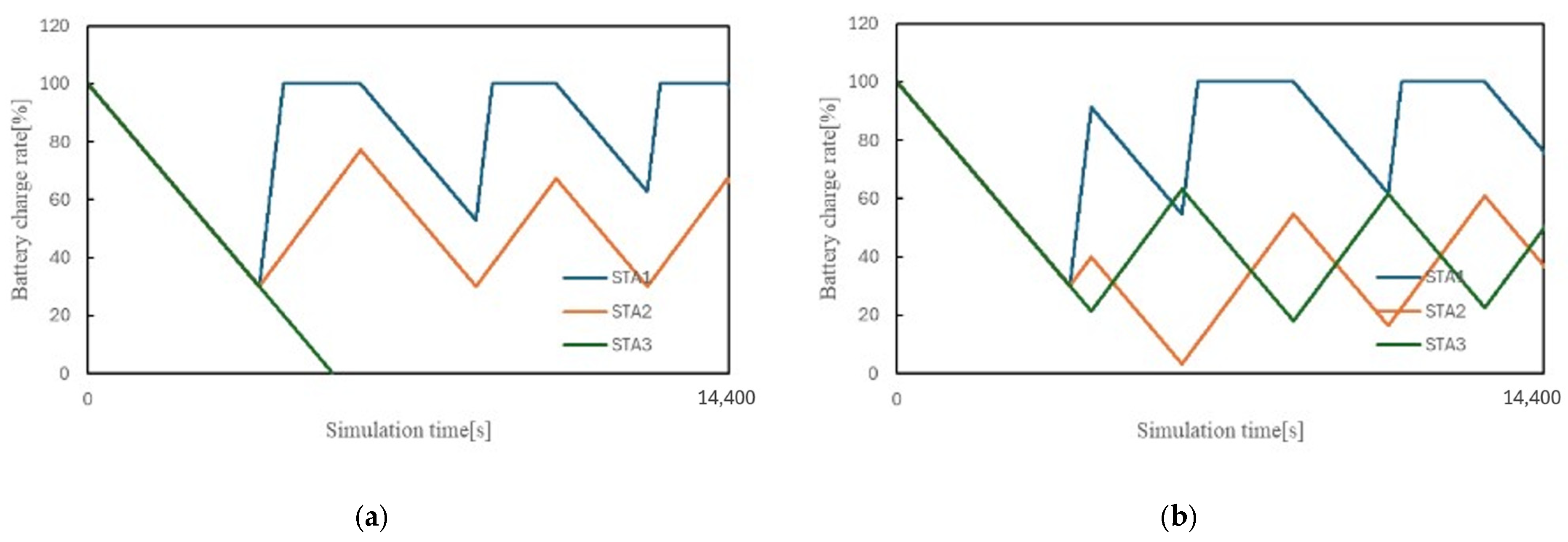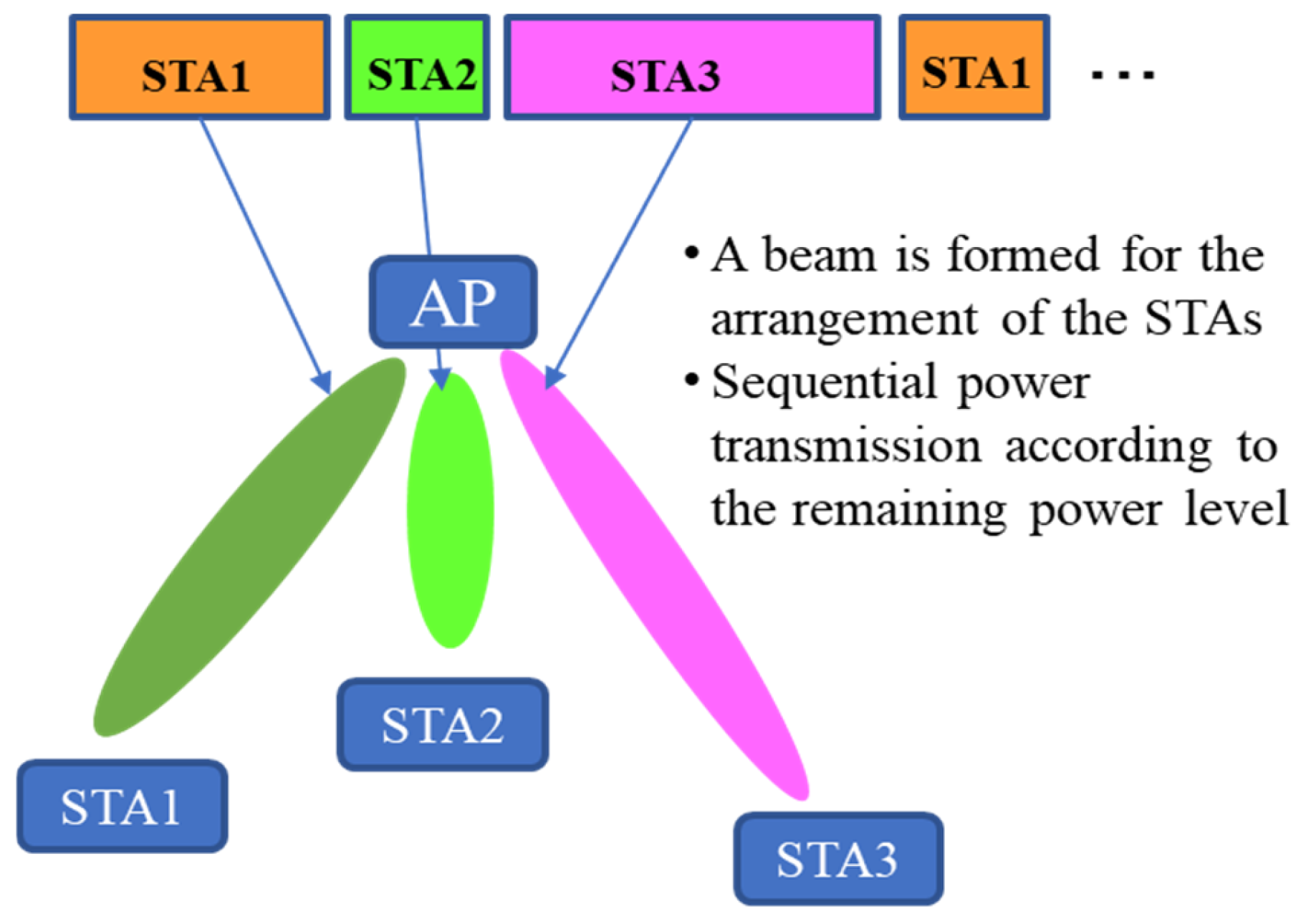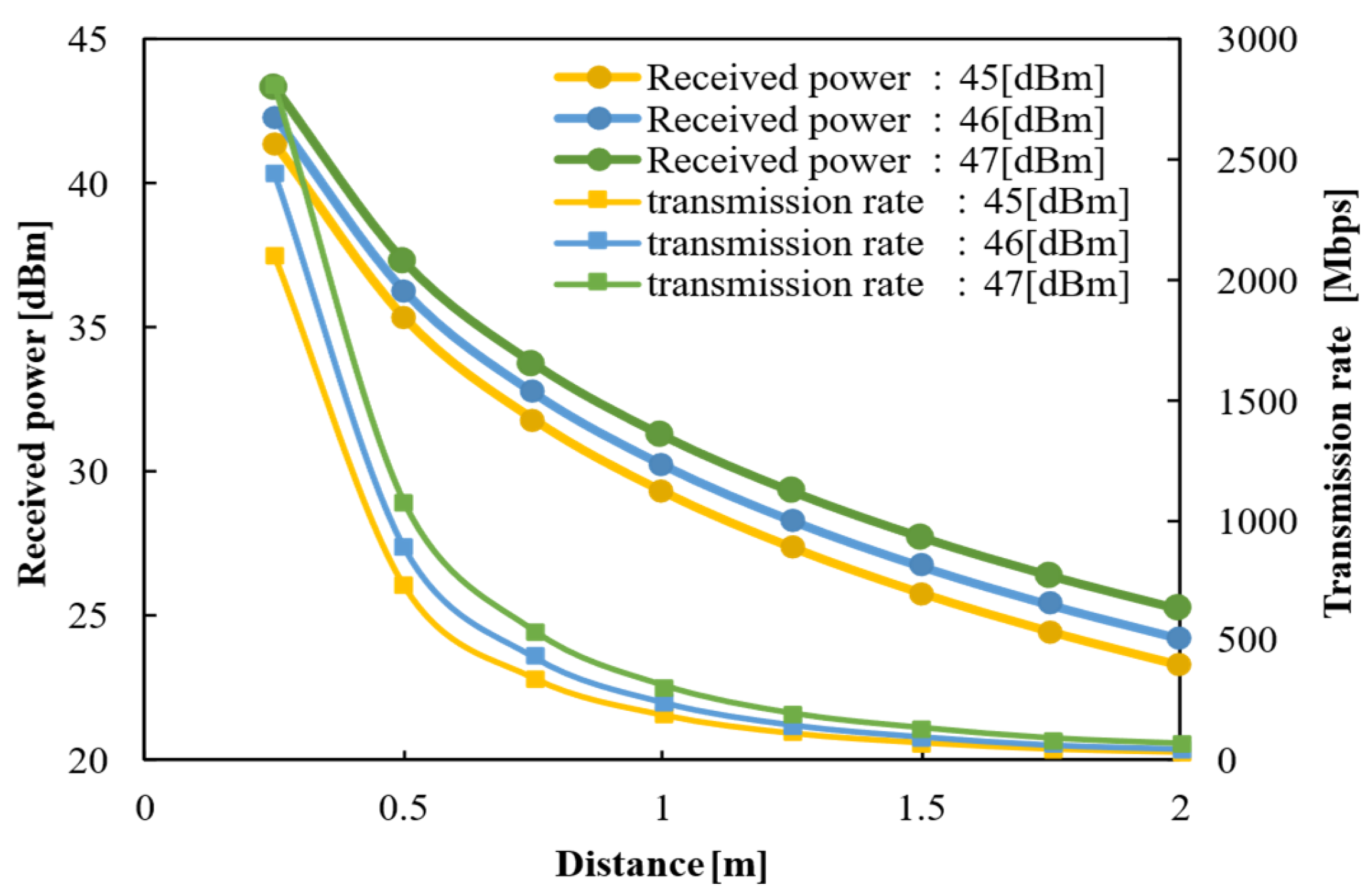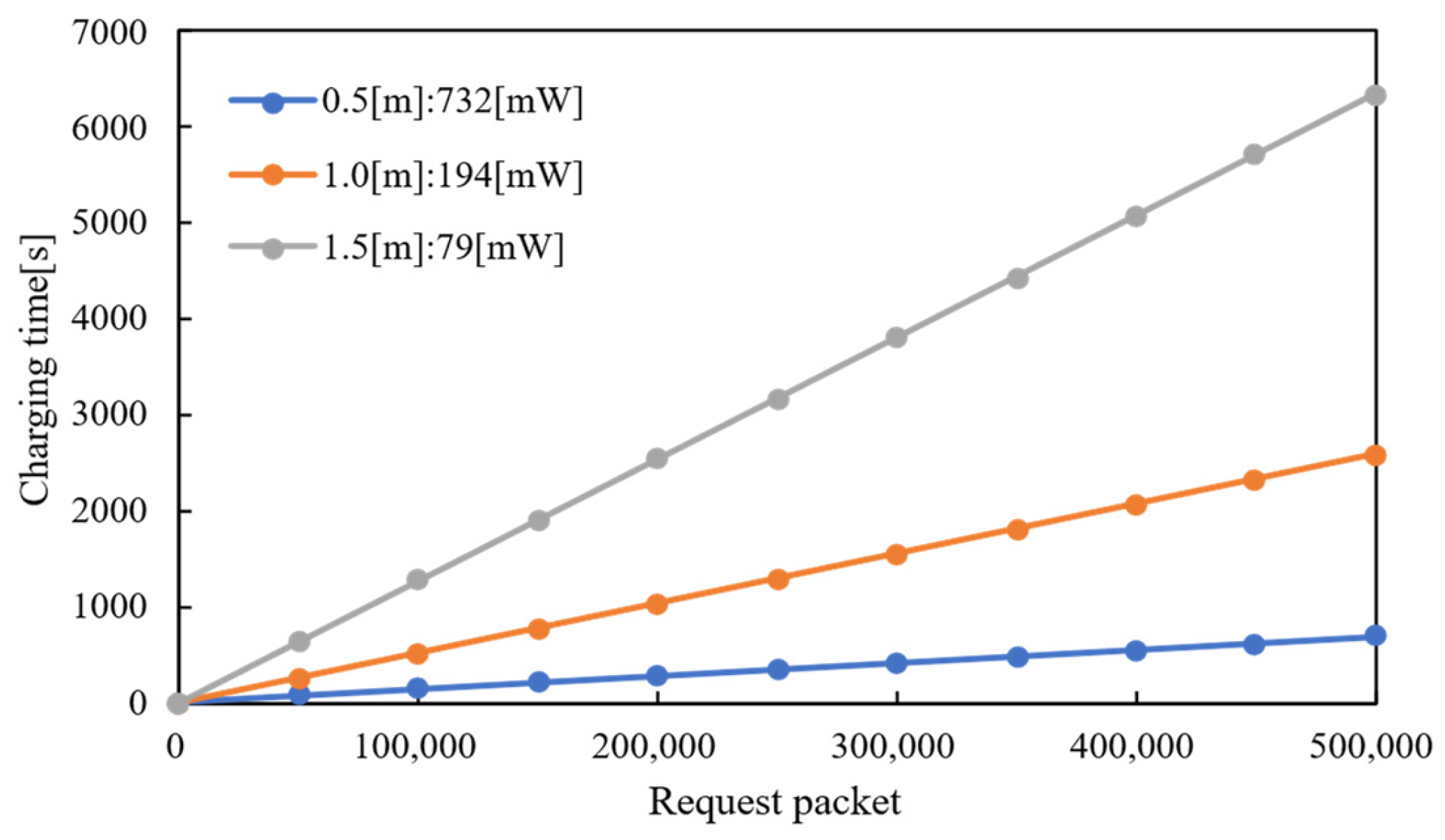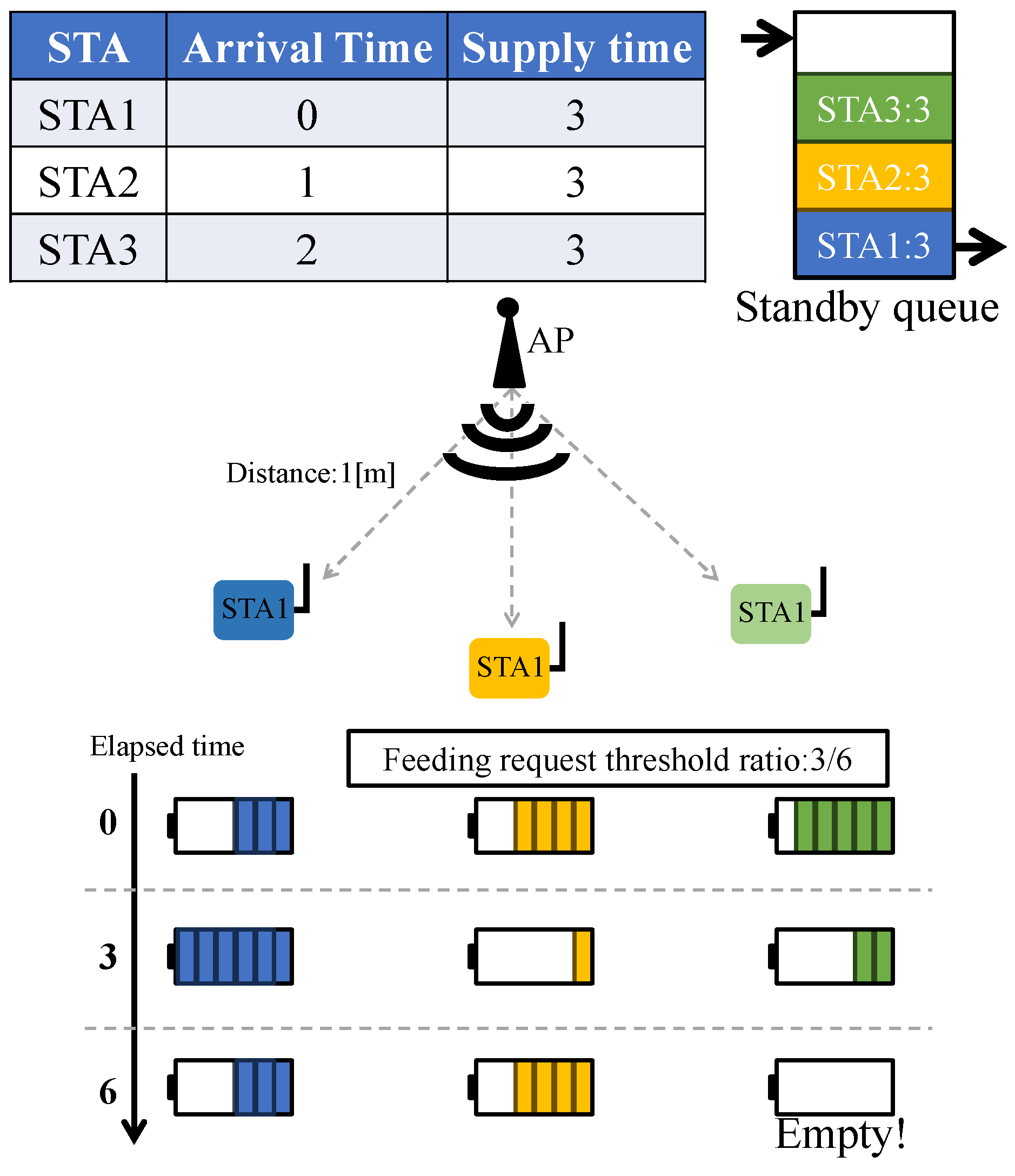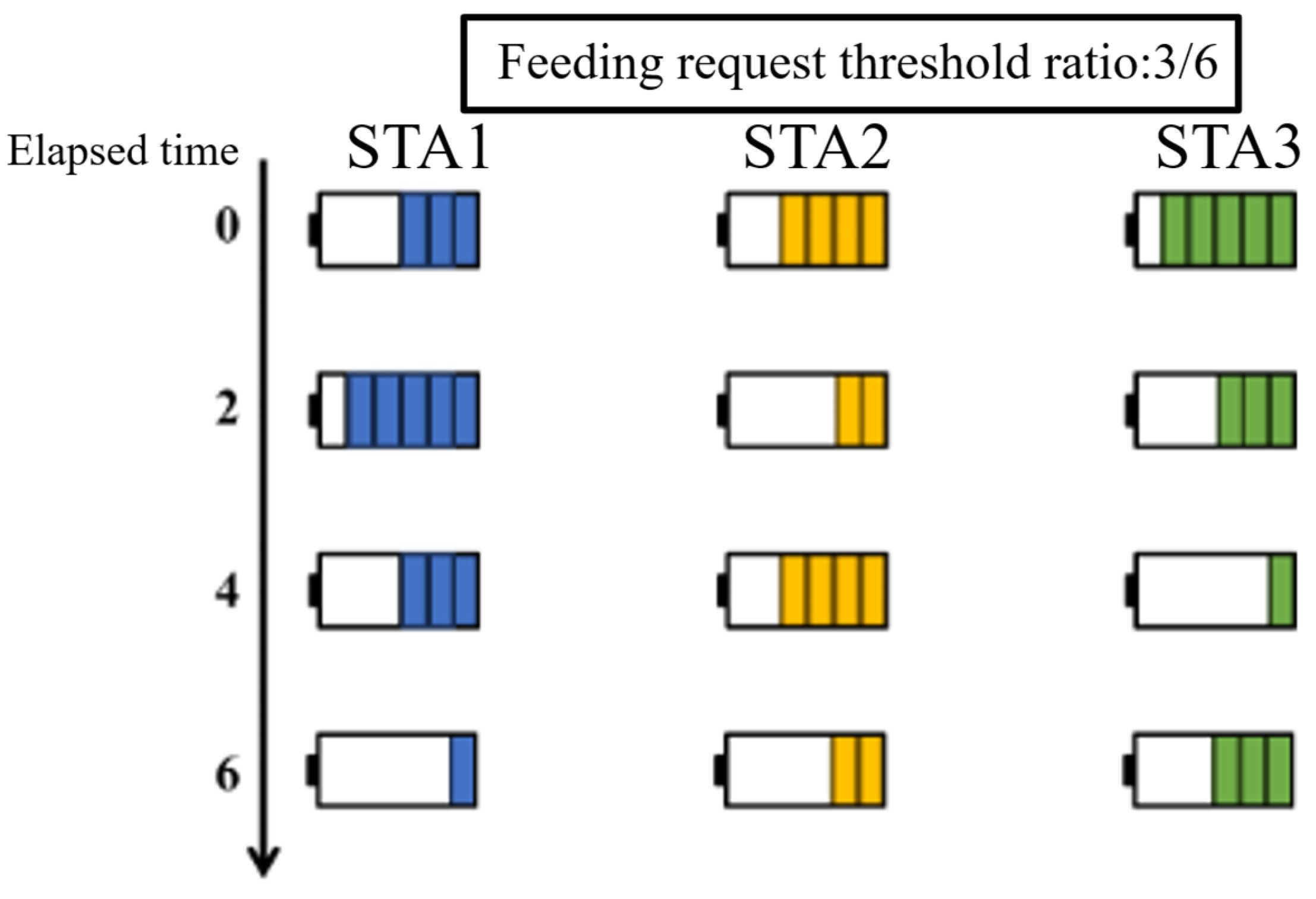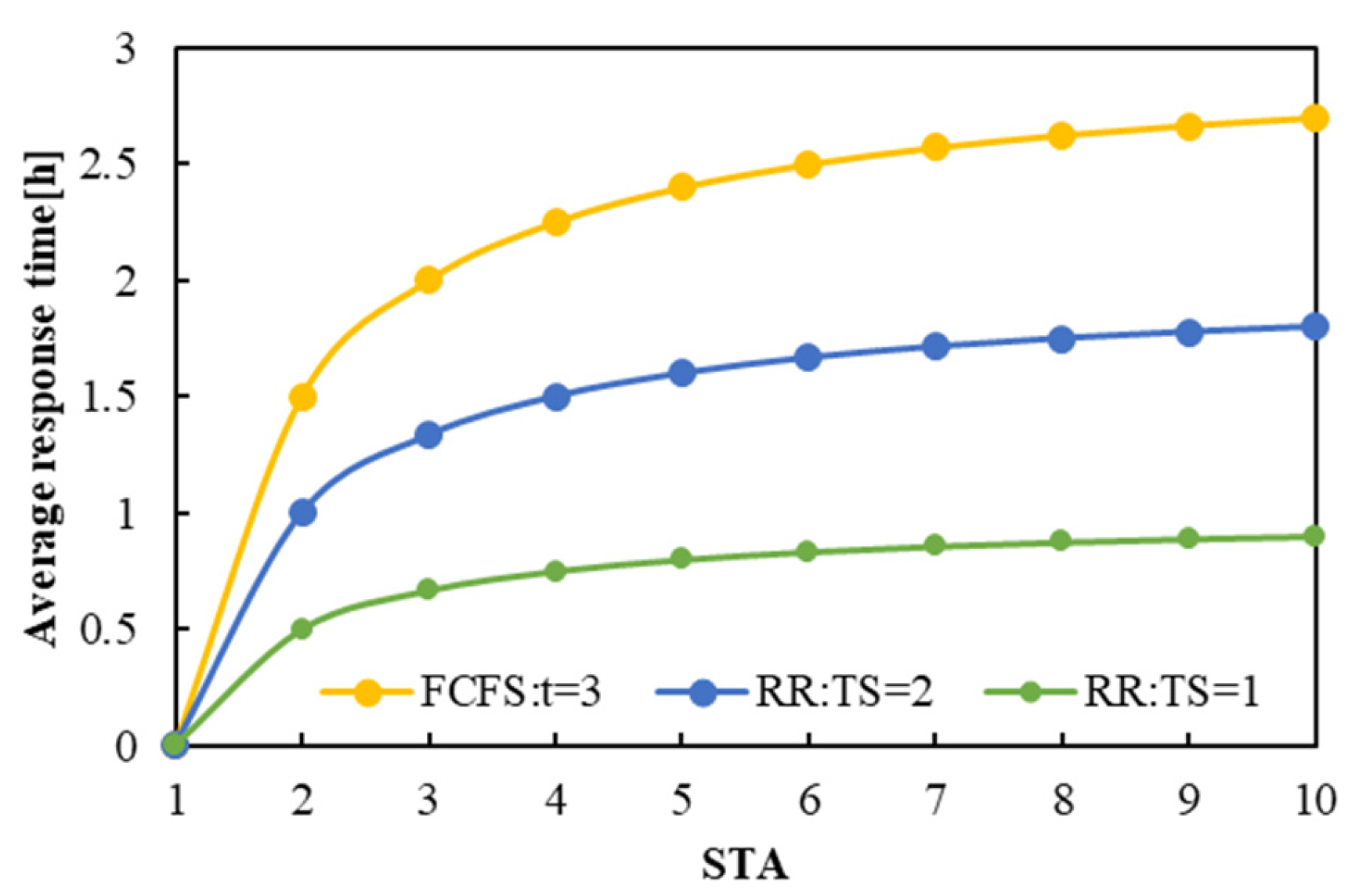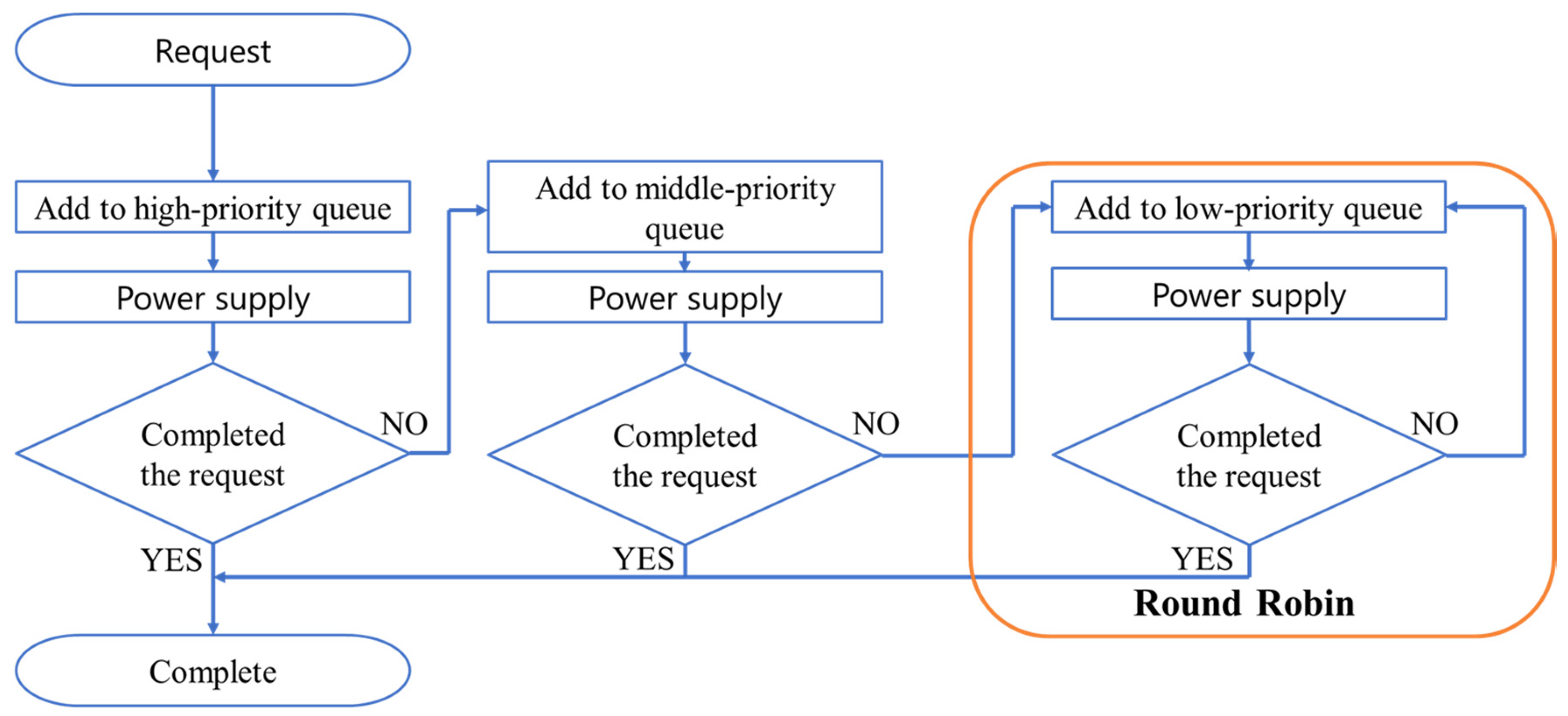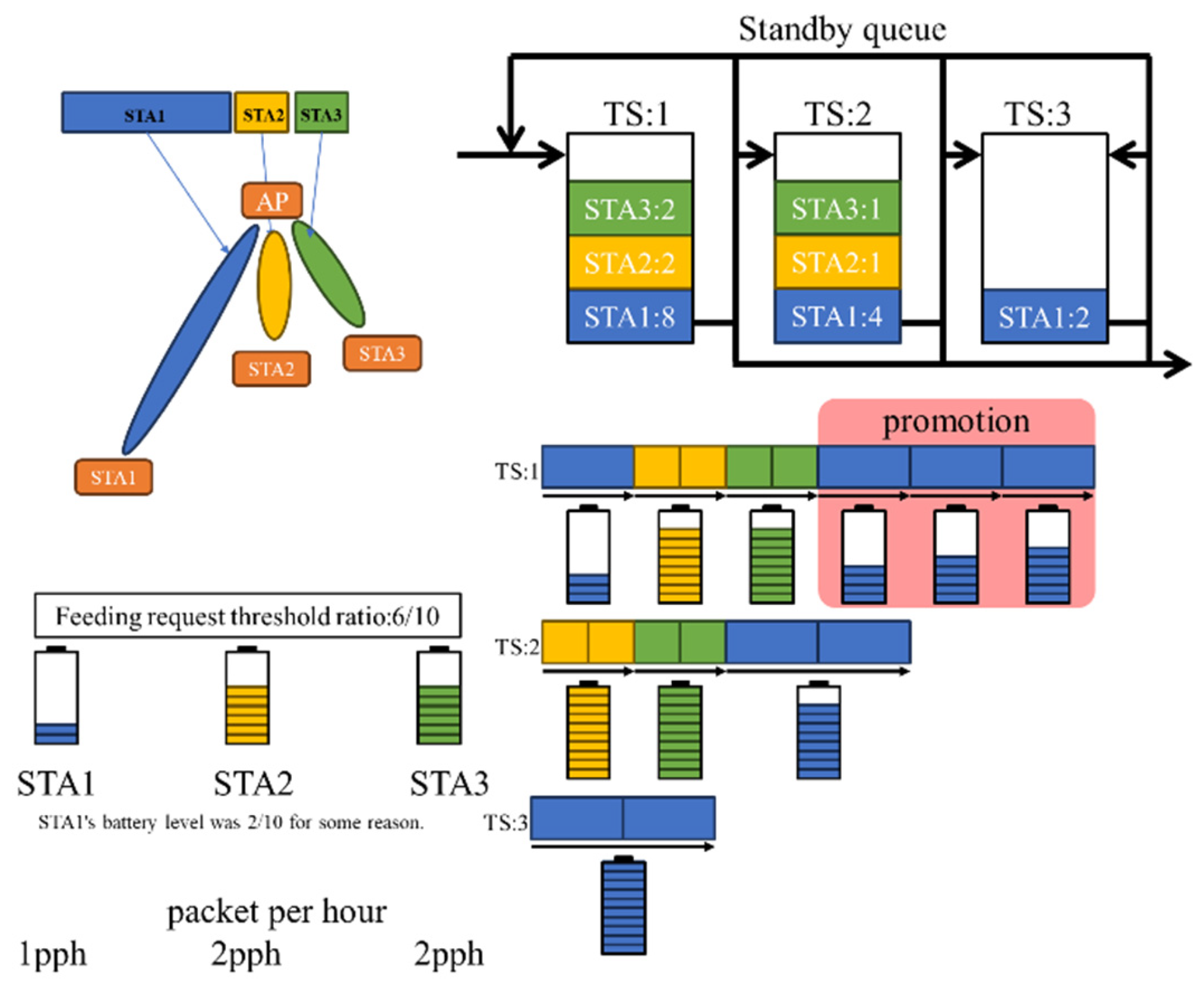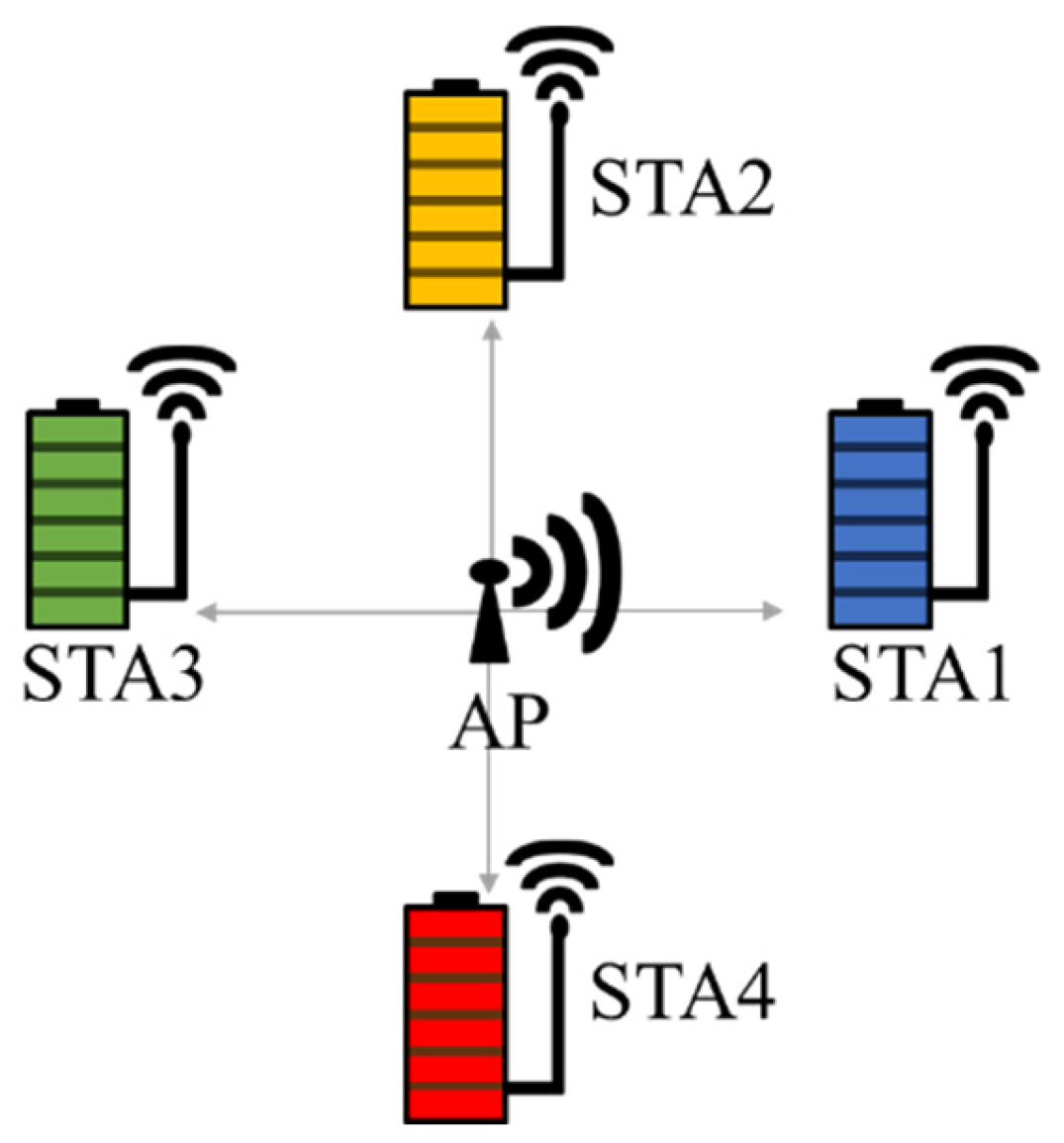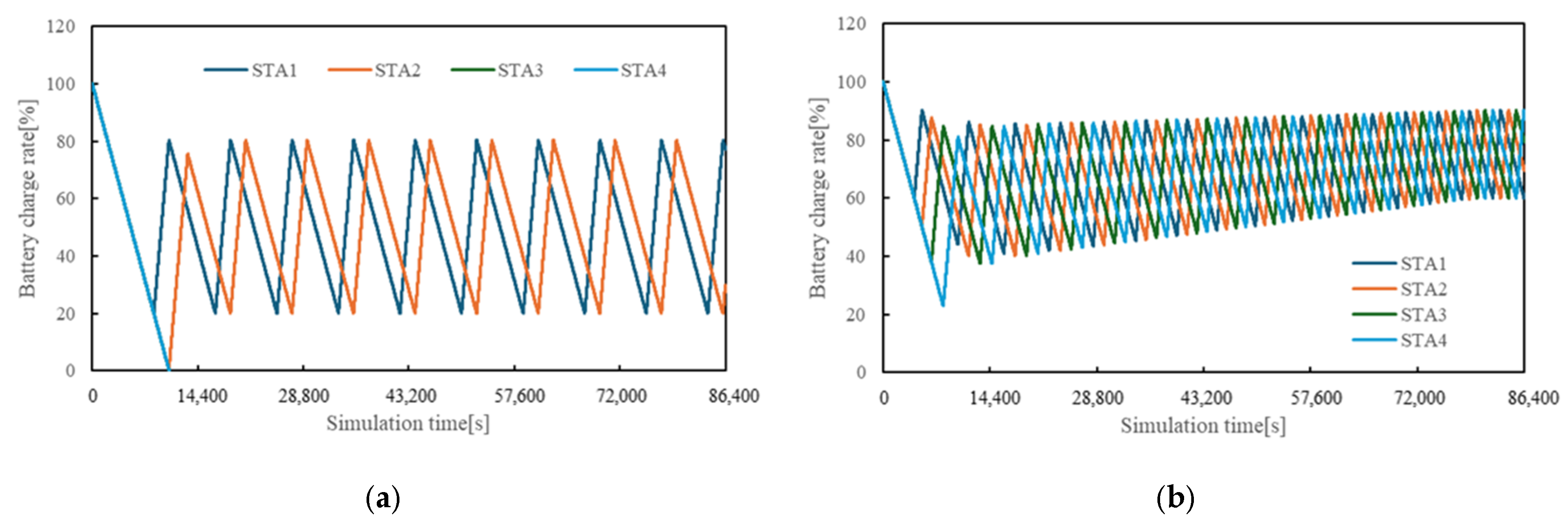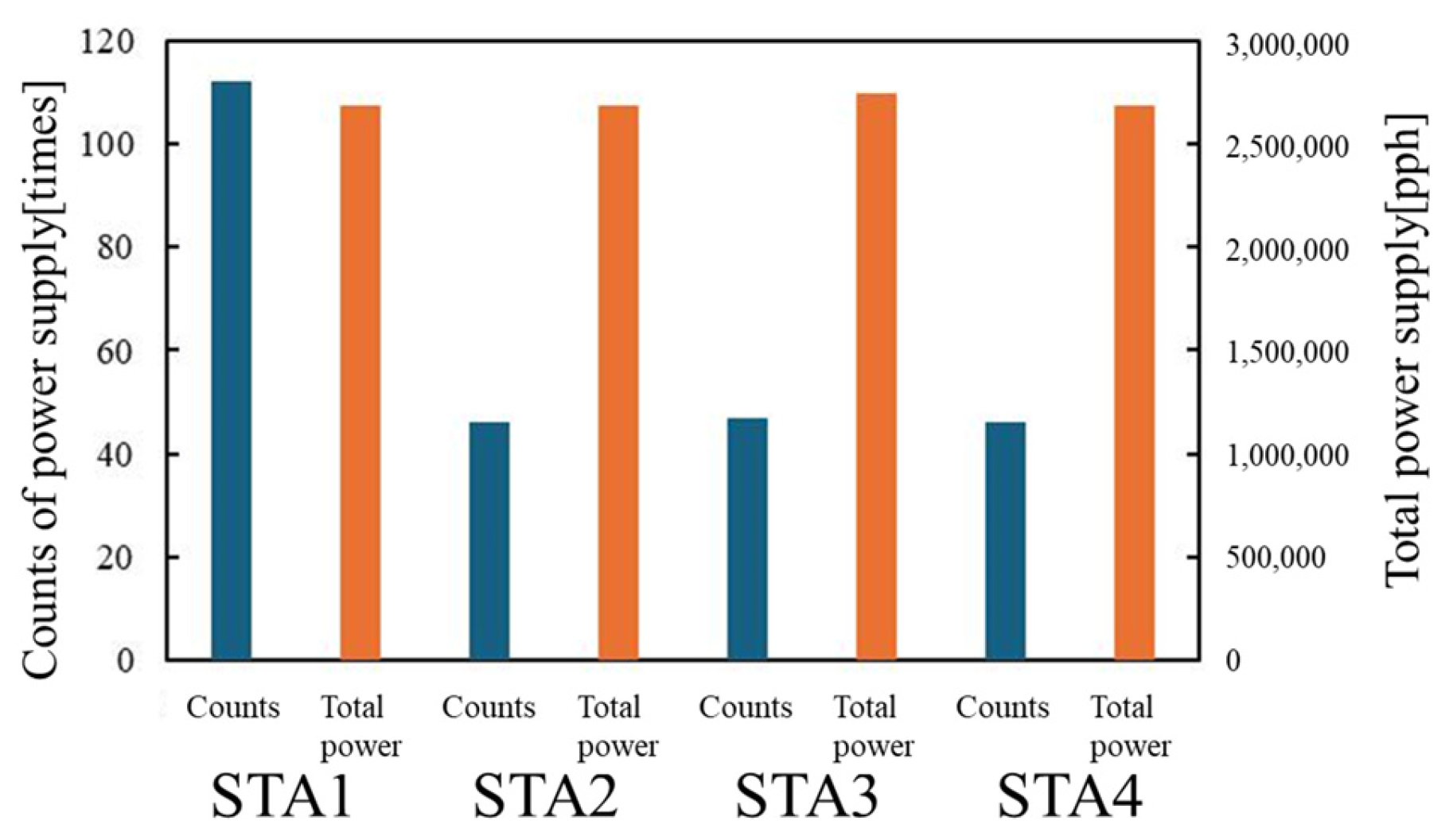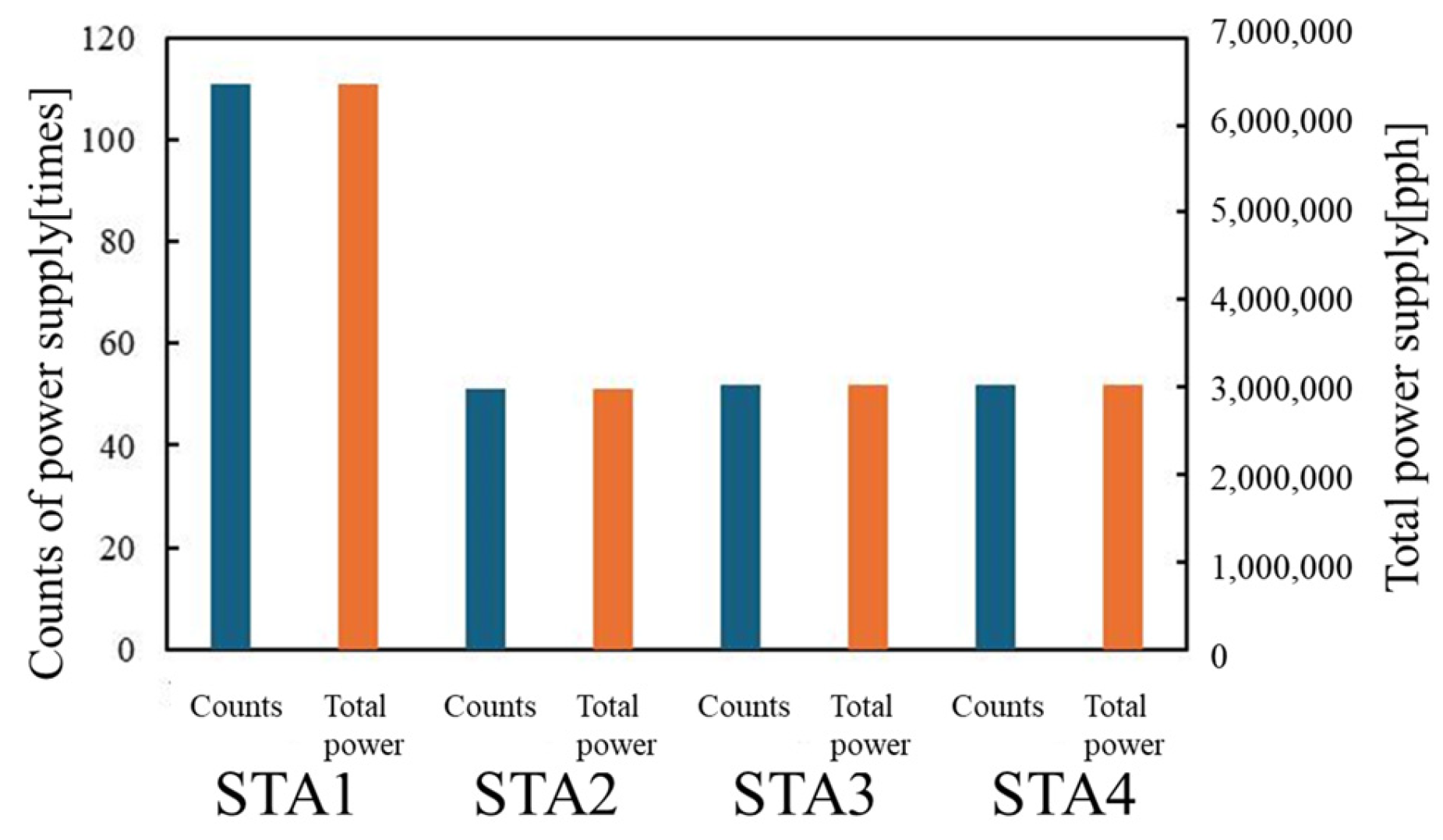1. Introduction
Wireless power transfer (WPT) has garnered significant attention in diverse disciplines owing to its potential for application in a wide variety of fields. In the context of everyday electronic devices such as smartphones and wearable devices, WPT enhances convenience by eliminating the need for charging cables and significantly streamlining the charging process for frequently used devices [
1,
2,
3]. In the domain of electric vehicles, the prospect of contactless charging while parked is anticipated to augment user convenience and expedite the development of charging infrastructure [
4,
5]. In the medical field, WPT presents novel opportunities, particularly for medical devices implanted in the body. For instance, cardiac pacemakers and insulin pumps can benefit from a wireless energy supply, thereby reducing the necessity for surgical battery replacement [
6,
7,
8]. Similarly, in industrial robots and drones, wireless charging can enhance maintenance efficiency and prolong operation time, thereby accelerating the automation processes in factories and warehouses [
9,
10,
11]. In remote and harsh environments, WPT can provide energy to sensors and communication devices in installations that are difficult for humans to access. For instance, observation equipment installed in mountainous regions or offshore platforms can receive consistent and stable energy supply even in the absence of conventional power sources [
12,
13]. These characteristics can significantly expand the use of Internet of Things (IoT) devices in areas where infrastructure development is difficult. This technology has also been attracting attention in the field of space exploration and is expected to be a new means of improving the efficiency of work and observation in space by wirelessly transmitting energy from the Earth to satellites and space stations. The prospect of wirelessly supplying energy to rovers and bases during lunar and Mars explorations is a future possibility, and technological advancements are being made in these fields toward this [
14].
WPT is usually achieved using four primary methods: electromagnetic induction, magnetic resonance, electric-field coupling, and electromagnetic wave (microwave) transmission [
15,
16]. Electromagnetic induction is commonly known as inductive power transfer (IPT), which transmits energy via magnetic fields generated between coils on the transmitter and receiver sides. IPT is one of the most widely adopted methods, seen in applications such as electric toothbrushes and smartphone charging pads [
15]. Electric-field coupling, on the other hand, is referred to as capacitive power transfer (CPT), which transmits energy through electrostatic fields between paired electrodes. CPT offers advantages in terms of its thin and lightweight design, as well as compatibility with high-frequency operation, making it promising for use in wearable and compact electronic devices [
16]. Among these, the electromagnetic wave method stands out for its ability to facilitate long-distance transmission and its distinct advantages for specific applications [
17]. This method uses high-frequency electromagnetic waves to transmit energy, and its compatibility with relatively simple power-receiving devices suggests a wide range of potential applications. A salient benefit of the electromagnetic wave method is its capacity for transmission over longer distances, when compared with that of alternative methods. Its utilization of multiple frequencies such as 920 MHz, 2.4 GHz, 5.7 GHz, and 24 GHz, depending on the specific application and characteristics of the surrounding environment, is also advantageous [
18]. The 5.7 GHz band, in particular, offers relatively substantial bandwidth, facilitating high-speed and reliable communication and power transmission. This property is particularly beneficial for avoiding interference from other frequency bands, such as the 2.4 and 5 GHz bands, which are susceptible to congestion. Furthermore, higher frequencies are associated with shorter wavelengths, which improve the directivity. This, in conjunction with beamforming techniques, enhances the efficiency of energy transmission, thereby optimizing the energy delivery to target devices. Consequently, high frequencies, such as 5.7 GHz, are particularly advantageous in terms of energy efficiency because factories and indoor environments predominantly require transmission over short distances [
19].
Figure 1 illustrates the range of applications for each device according to the transmission distance in relation to the equivalent isotropic radiated power and the amount of power received.
In this work, we propose an access-control methodology for scheduled power delivery to multiple power-receiving terminals (stations (STAs)) in indoor environments. To facilitate the transmission to multiple STAs, power is delivered through beamforming. The concept of power transmission through beamforming [
20,
21,
22,
23] has been extensively explored in numerous studies, with a significant focus on the development of antennas for multibeam formation. However, in the context of multibeam WPT with multiple receiving STAs, challenges exist associated with the efficient and safe supply of power to multiple receivers. Specifically, the power required for each receiver must be appropriately distributed, and energy leakage outside the target must be minimized. In addition, a beam arrangement that can accurately supply power to nearby receivers while suppressing the interference among multiple beams is required. However, the complexity of such beam control may increase the overall load on the communication system. Furthermore, indoor and factory environments are prone to energy losses owing to reflection and absorption. To address these challenges, a promising approach involves the implementation of a scheduling technology capable of managing the power supply to multiple receivers by dividing the power supply over time. This proposed approach is defined as power time-division delivery (PTDD) and allocates power to receivers according to a predetermined schedule. When employed in conjunction with beamforming, PTDD can enable more efficient and flexible power delivery. This paper proposes a PTDD-based scheduling method and aims to verify its effectiveness.
Recent studies on scheduling in power transfer have focused on storage-aware methods that take energy capacity into account, as well as enhanced power delivery schemes leveraging beamforming [
24,
25]. In particular, time-division scheduling methods that dynamically allocate power based on the energy state of the receiver have been studied [
26], and these constitute a foundational approach for our proposed PTDD (power time-division delivery) method. Furthermore, a concept similar to ours is seen in power packet-based control methods [
27], where each power packet contains metadata such as transmission time, device ID, and requested power amount, enabling fine-grained scheduling and control. However, that existing study assumes a wired power transmission network and poses challenges when applied to infrastructure-based wireless systems. In contrast, our PTDD method is designed for infrastructure-based wireless power transfer systems and features flexible and efficient power allocation under wireless environments. That is, optimal power distribution among multiple devices is a critical issue in such systems, and we address this by introducing power packetization. Our method achieves real-time and dynamic power scheduling by managing the power supplied to each device through queue control, akin to techniques used in communication networks, which is a key advantage of our approach.
The allocation of beams must also be optimized according to the remaining storage capacity and power demand of each receiver. Although scheduling is required to supply power preferentially to receivers with low storage capacities, the allocation of limited resources is also technically complex. Furthermore, if the receivers are located far from the transmitter, the power-transmission efficiency will decrease significantly because of power attenuation, and the beamforming allocation time and frequency must be adjusted to compensate for this attenuation [
25,
28]. Furthermore, given that power transmission is inherently analog, synchronizing transmission timing and switching power distribution among multiple receivers poses significant challenges. Unlike in telecommunication, interference does not occur between multiple beams. Rather, there is an advantage in that interference allows power to be supplied to nearby receivers that are not targeted [
24]. This necessitates advanced control that utilizes the unique advantages of power transmission, such as dynamic beamforming and waveform optimization [
29].
Therefore, a novel approach is required to address the limitations of analog transmission and efficiently perform scheduling while leveraging these characteristics. The configuration of multibeam power transmission is illustrated in
Figure 2. Assuming that the power transmitter functions as an access point (AP), power is sequentially delivered to multiple STAs by PTDD, contingent on the remaining storage capacity of the STA and other factors. We propose a “power-equivalent packet scheme” that converts power into small packet units and dynamically controls the delivery timing to each receiver. In this scheme, the amount of power is treated pseudoactively as the communication speed and the number of packets sent and received in the communication network. The scheduling methods used in communication networks can be easily applied here. The packet-based scheduling method offers several advantages, including flexible power allocation in real time and the ability to manage the fed power with a simple receiver queue count. In other words, the power-equivalent packet method is suitable for scheduling because it can be combined with beamforming techniques to achieve efficient power delivery to multiple receivers. The solution to the following problems can be achieved using the packet-based scheduling method:
- (A)
Power conversion to packets;
- (B)
Optimization of power delivery by scheduling.
(A) involves methods for converting power into packets and the relationship between the attenuation and transmission time, depending on the distance from the AP. (B) involves a PTDD method that uses optimal scheduling based on the placement of STAs and power consumption of each STA. This model contains limited discussion regarding the effects of reflections and obstacles. The reason is that the received power is determined by the functionality of the ray-tracing simulator. The effects of reflections and obstacles can be fully accounted for through ray tracing. In this process, reflected waves generally follow longer paths compared to direct waves, resulting in significantly lower received power and thus having minimal impact. Moreover, when direct waves are blocked by obstacles, the received power drops drastically to a negligible value (or even zero).
Section 2 explains the bucket conversion method for power and the model of the behavior during power supply using the proposed method for each scheduling.
Section 3 evaluates the proposed method using computer simulation and shows its effectiveness.
Section 4 is the conclusion, and
Appendix A provides supplementary information on group power supply.
3. Results
To conduct the evaluation, a model was created using a WPT simulator (see
Figure 15). In this model, four power-receiving terminals (STA1–STA4) were placed 1 m from the AP. The distance between the terminals was kept constant, and they were positioned on four sides of the AP to prevent interference from the power transmission beam. These evaluations were conducted through computer simulations. Although the simulator is typically used to evaluate communication network models, we developed an additional program to convert packet-based communication models into power packets, allowing us to evaluate them in terms of power [
31].
Table 1 lists the parameters common to all STAs. Interpreting each packet as a unit of mWs, the insertion of one packet into the queue indicates that 1 mW of power has been supplied to the battery. Therefore, 500,000 packets correspond to a received power of 500 W. These parameters were determined based on the capacity of a typical button-cell battery and the power consumption of light-emitting diodes. The battery capacity represented the queue size in the simulation, which could store up to 500,000 packets. The packet discard interval was the inverse of the power consumption. The power consumption
P in this model is given by Equation (8).
The total power consumption of the model was estimated to be approximately 190 mW, and the received power at a distance of 1 m was 194 mW. Consequently, when the power supply was sufficient, depletion did not occur. The power-supply request threshold was set to 20% as the criterion for determining the power supply. When the remaining battery power fell below this threshold, the system initiated a powering process. The transmission power and antenna gain were set with reference to the values specified in the WPT standards.
3.1. FCFS Scheme Evaluation
As illustrated in
Figure 16, battery transition was contingent upon the FCFS scheme. In this model, 194 mW of power was supplied to the STA, which was less than the STA’s total power consumption of 190 mW. Typically, the battery would not have been depleted because the amount of power supplied exceeded the amount consumed. However, as shown in
Figure 16a, the STA3 and STA4 terminals were powered on later, resulting in depletion within 3 h after the start of the simulation owing to the extended waiting period. Subsequently, the two terminals maintained stable operation.
Figure 16b presents the outcomes when the power-supply request threshold for the STA common parameter was increased to 60% (power was requested when the value fell below 60%). By establishing a higher threshold, all terminals functioned without depletion. It can be concluded that establishing a higher power-supply request threshold reduces the time required to supply power to each STA and mitigates the occurrence of depletion. These outcomes underscore the necessity of calibrating the threshold according to the specific characteristics of the application. In summary, the FCFS scheme may encounter challenges in effectively managing STAs with disparate power consumption and varying distances from one another.
3.2. RR Scheme Evaluation
The RR scheme operates in a manner contingent upon the TS value; that is, the behavior of the RR method varies depending on the TS value. To elucidate this variation, the behaviors were compared for TS values of 25, 15, and 5 min.
Figure 17 shows the RR battery level. When the TS was set to 25 min, STA3 and STA4 were depleted because they could not be switched in time; when the TS was set to 15 min, only STA4 was depleted; and when the TS was set to 5 min, the battery was not depleted. These findings indicate that as the TS decreases, the battery level increases.
3.3. MFQ Scheme Evaluation
The effectiveness of the MFQ scheme was verified because it has the functionality of promotion processing in addition to RR, and the queues for MFQ-scheme evaluation were simulated with TSs of 5/15/25 min, in sequence, according to priority (see
Figure 18). The figure shows the difference in the battery transition with and without the promotion process when using the MFQ scheme.
Figure 18a illustrates the scenario devoid of a promotion process, where STA4 experiences depletion owing to the prolonged power supply to a terminal that transitioned to a lower queue. Conversely,
Figure 18b depicts a scenario involving the execution of the promotion process, resulting in the maintenance of the residual power level at a comparable magnitude across all terminals, without any depletion.
3.4. STA Placement Distance Evaluation
It was confirmed that the MFQ scheme could maintain a more stable power supply than the RR scheme by performing a power-up process. However, in a real environment, the power supply conditions may change, such as a temporary and sudden decrease in the power supplied or an increase in the power consumption. Therefore, configurations with different STA arrangements were constructed and evaluated. As discussed previously, the time required to complete packet reception increased with increasing distance between the receiving terminals, leading to a reduction in the power consumption.
The conditions under which the placement distances differ are delineated as follows: As illustrated in
Figure 19, STA1 is the sole terminal configured with an AP distance of 1.5 m.
Table 2 presents a comparison of the common parameters used in this evaluation. The packet discard interval is augmented to 32 ms to address the decline in power reception resulting from the change in distance.
Figure 20 shows the simulation outcomes of the RR and MFQ schemes, for comparison.
Figure 20a illustrates a scenario in which the RR scheme is employed. While the RR scheme ensures balanced power distribution, distant terminals exhibit higher power consumption during standby, compared to their reception in a single feed, leading to a transient decline in the battery power. Consequently, STA1’s battery capacity is depleted when the RR scheme is implemented. In RR, an issue was identified wherein a remote terminal required a significant duration to surpass the designated power-supply request threshold. As illustrated in
Figure 20b, the TS of each queue in the MFQ was set to 5 min. It was verified that STA1 possessed the capability to preserve its storage capacity without reaching depletion, which was facilitated by its numerous opportunities to receive power subsequent to other terminals’ relocation to a lower queue through a promotion process involving resupply requests.
Figure 21 shows the total number of times each terminal receives power and the total amount of power supplied. It is evident that STA1, situated at a considerable distance from the other terminals, received 110 power-supply opportunities, which was more than double the number received by the other terminals (approximately 50 opportunities). Consequently, STA1 obtained the same total power supplied as the other terminals owing to the greater number of times it received power. In this evaluation, the TS was set to 5 min for both the RR and MFQ schemes. The MFQ scheme maintained the remaining battery capacity and avoided depletion by prioritizing the number of power-transmission opportunities through the promotion process. The MFQ method is considered to have been able to maintain the remaining battery capacity and avoid depletion.
3.5. Different Power Consumption Evaluation
In the subsequent analysis, a comparative evaluation of the RR and MFQ schemes was conducted in relation to their disparate power consumption profiles. The STAs under scrutiny were arranged in an equidistant configuration at a distance of 1 m, as illustrated in
Figure 15.
Table 3 presents a comprehensive list of the common parameters and their respective modifications implemented in this evaluation. To emulate the power consumption, STA1 was configured to 13 ms, whereas the remaining STAs were set to 27 ms, thereby doubling the power consumption of STA1.
The evaluation results of the RR and MFQ schemes, both of which set the TS to 5 min, are shown in
Figure 22.
Figure 22a presents the evaluation using the RR scheme. Although the RR scheme provided fair power-supply opportunities, the power consumption during standby exceeded the amount of power supplied at one time to the terminal with the highest power consumption, resulting in a rapid decrease in the remaining battery capacity and depletion of the storage capacity. By contrast, the MFQ scheme (see
Figure 22b) demonstrated a more effective approach. Here, STA1 utilized a promotion process involving resupply requests to obtain additional power-supply opportunities, effectively maintaining the battery capacity without depletion. The evaluation of the number of times MFQ receives power and the total amount of power received is shown in
Figure 23. Notably, STA1, which had the highest power consumption, received 110 opportunities, more than twice the number received by the other terminals (approximately 50 opportunities). In this model, the received power at each terminal was equal. However, STA1’s greater number of power-supply opportunities resulted in it receiving more than twice the total power supplied to the other terminals. The shortest TS for both schemes was 5 min. However, the MFQ scheme’s ability to maintain a higher battery level and avoid depletion was evident through its division of priority levels.
3.6. Analysis and Discussion of Each Scheme
The simulation results indicate that the FCFS scheme is the most susceptible to cause battery depletion, which may be attributed to its prolonged response time. In the FCFS scheme, requests are processed in the order in which they are received, thereby increasing the response time, and consequently accelerating battery depletion. Conversely, the RR scheme functions with a higher value of remaining battery power when the TS is set to a shorter duration. Reducing the TS duration reduces the response time for each receiving terminal and facilitates more efficient power supply. The results of the MFQ scheme exhibit substantial variation depending on the TS promotion. The MFQ scheme operates with a battery life equivalent to that of an RR scheme with a short TS. Specifically, the MFQ method reduces the response time and enables an efficient supply of power by upgrading from a low-priority queue to a high-priority queue. In scenarios where the terminal distances vary, the MFQ scheme and its upgrading process prioritize distant terminals, ensuring that they receive power ahead of the nearby terminals. In addition, the MFQ scheme and its upgrading process can be utilized to allocate priority to terminals with higher power consumptions when their power consumption differs from that of distant terminals. This approach ensures that terminals with high power demands receive power preferentially, thereby enhancing the overall efficiency. In summary, the RR and MFQ schemes have been shown to facilitate more efficient battery utilization than the FCFS approach. Notably, the capacity of the MFQ scheme to adapt to varying distances and power consumptions, through its promotion process, makes it a particularly effective solution.
4. Conclusions
In this study, we proposed a novel power–packet conversion method that is compatible with the existing network and computer-processing scheduling methods. We evaluated three scheduling schemes: FCFS, RR, and MFQ, and confirmed that the latter was the most suitable for efficient power supply while preventing battery depletion. This scheme is expected to be used not only to remotely transfer power to IoT terminals and other devices but also in applications where only wireless transmission (without physical wiring) is feasible.
The scope of this study is constrained to the fundamental operations and performance comparisons of the respective schedulers. Subsequent research will encompass the examination and evaluation of operational methodologies for more pragmatic applications, along with the derivation of optimal parameter settings. Furthermore, we intend to implement the devised power–packet conversion method and scheduler within an authentic power-transmission system and substantiate their efficacy through demonstrative experiments.
In this study, we assume that, unlike communication terminals, the terminals in the wireless power transfer model are stationary and do not move dynamically. Therefore, terminal mobility is not evaluated. If mobility is to be considered, beam-tracking functionality at the transmitter side would be required. The effects of surrounding reflections are also not considered. This is because wireless power transfer experiences significant attenuation, and multipath components due to reflections are further attenuated, resulting in minimal impact on the direct wave, including interference and resonance. However, in practical applications, evaluations under such special conditions may be necessary, and we consider this an important topic for future research.
The behavior of the battery in this simulator can be configured to simulate nonlinear characteristics. However, in this study, the charging and discharging of the battery are assumed to be linear in order to simplify the comparison of scheduling methods. In addition, this simulator does not incorporate delay. The primary reason is that the delay in this context is extremely short compared to the power transmission and reception time. Additionally, the loss caused by such delay is negligible, even when compared to the minor losses due to reflected waves in real environments. As for positional shifts, they will be addressed in future work by developing a simulator that considers device mobility, along with implementing related features. Moreover, the reason that transmission delay is not incorporated in the current simulator is that, unlike communication networks, the delay in power transmission is extremely short compared to the time it takes to receive the power and can be considered negligible. In addition, the energy loss due to delay is smaller than the loss due to the weakness of reflected waves in the real environment. The effect of misalignment will be verified through comparative experiments using actual power transmission hardware that is currently under development.
As a future direction, we plan to incorporate nonlinear battery discharge characteristics into the simulation. For example, packet drop behavior can be modeled based on battery-specific discharge profiles, which would enhance the realism and accuracy of the evaluation. In addition, we are currently developing hardware for the proposed system, and comparative validation between the simulator and the actual hardware implementation is planned as part of our ongoing studies.

